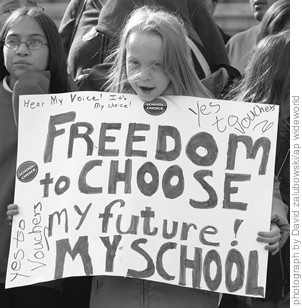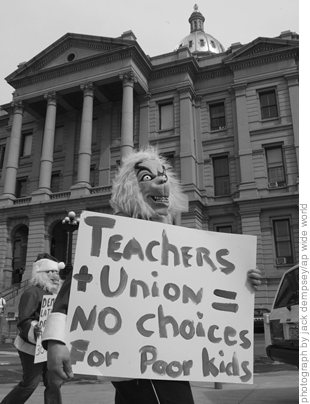
In April 2003 the Colorado legislature created a school voucher program that has the potential to become one of the largest in the nation. Initially the number of children eligible for vouchers will be limited to 1 percent of the student population in each of the 11 low-performing school districts targeted by the legislation, or about 3,400 students overall. But by the program’s fourth year in operation, when the cap permanently rises to 6 percent, up to 21,000 students statewide could be using state-funded vouchers to attend private and religious schools.
Coming on the heels of the U.S. Supreme Court’s Zelman decision, approving the public funding of religious schooling, Colorado’s program was the first enacted without the cloud of a potential First Amendment challenge. Yet that did not inoculate it against a legal attack. Opponents filed suit in May 2003, alleging that the program ran afoul of the Colorado state constitution’s guarantee that local school boards “shall have control of instruction in the public schools of their respective districts.”
In December a state trial court judge sided with the plaintiffs, ruling that the program violated the state constitution’s local control provision by giving Colorado school boards no “input whatsoever into the instruction to be offered by the private schools” that accepted voucher students. In June 2004, the Colorado Supreme Court upheld the lower court’s ruling, with the majority holding that the “statewide system of school finance is designed to preserve local control over locally raised tax revenues.” The voucher program is on hold unless the state legislature can create a more acceptable funding and regulatory structure for it.
Nevertheless, voucher legislation is under discussion in many states, and Colorado provides an opportunity to examine what it takes to establish a program. Like many controversial yet successful policy initiatives, voucher legislation was enacted in Colorado due to a kind of “perfect storm”-a confluence of unlikely events and trends that came together simultaneously. In Colorado, these factors included a state that has become increasingly Republican and thus receptive to conservative ideology; Republican majorities in the state legislature and a Republican in the statehouse; a large, disenfranchised minority community of Latinos with children trapped in low-performing schools; the support of several key Latino business groups, advocacy groups, and elected officials; and a maverick Democrat willing to support a plan he believed would benefit his constituents.
 |
| Colorado deputy attorney general Renny Fagan (right) leaves courthouse after taking part in arguments about the school voucher program.
|
Receptive to Choice
Colorado has long been in the forefront of the school choice movement. In 1993 it became one of the first states to pass legislation enabling the creation of charter schools. Likewise, Colorado offers intra- and interdistrict public school choice statewide. Homeschooling is also an increasingly popular option in Colorado. The widespread adoption of public school choice coupled with the existence of vibrant alternatives to traditional public schools enabled lawmakers to lay the groundwork for vouchers.
However, voucher-type proposals have not been successful in statewide ballot initiatives. In 1992 an initiative that would have provided a voucher to any student, regardless of family income, for use in private schools was defeated by a two-to-one margin. Six years later, a proposal to give tax credits to families who pay tuition for private schooling was defeated by 60 percent of voters.
But with Republicans controlling the state legislature, Bill Owens, the first Republican governor elected in Colorado in 30 years, made it clear that he intended to sign a voucher bill into law during the 2003 legislative session. Throughout his political career, Owens had strongly supported expanded public and private school choice in Colorado, going so far as to publicly endorse pro-voucher candidates for school boards. He was also one of the primary architects of Colorado’s strong charter school legislation. Moreover, in the spring of 2004, he signed a bill that will provide state higher education aid directly to students in the form of a voucher for use at the schools of their choice. In the past, aid flowed to the institutions.
Various voucher bills were floated during the 2003 legislative session. Among them, two would have provided tax credits to organizations that made donations to K-12 scholarship programs. These proposals were similar to the programs in Arizona, Pennsylvania, and Florida, but they garnered little support due to hefty price tags and tight state budgets. Senator Ed Jones offered a proposal to create an experimental scholarship program in three school districts-and presented the state senate appropriations committee with a $78,300 check from a special-interest group to fund the plan. But Jones’s bill failed to pass the senate.
Support ultimately coalesced around the bill introduced by Republican Nancy Spence, chair of the house education committee. Like the successful legislation in Milwaukee, Cleveland, and Washington, D.C., the Spence bill was sold as a program to help low-income students escape failing schools. It restricted vouchers to students performing at an “unsatisfactory” level in 11 school districts that the state has rated “low” or “unsatisfactory.” Parents could enroll their child at a private or religious school with a voucher worth up to 85 percent of the district’s per-pupil funding (as much as $4,500). The balance of the per-pupil funding was to remain with the school district. Other districts could opt into the program if the local school board approved-an unlikely outcome.
As in Washington, D.C., where the federal government agreed to send $2 in aid to the public schools for every $1 it spent on the voucher program, Spence found it politically necessary to continue sending 15 to 25 percent of the per-pupil funding to the school districts for each student who chose to use a voucher. Addressing the complaint that a district’s fixed costs do not decline in direct proportion to the number of students who exit the system, Spence stated, “I recognize that [public schools] have certain fixed costs,” although she noted that “essentially the districts are making a profit on students they don’t educate.”
Opponents alleged that the voucher law could cost the public schools more than $90 million a year by 2007, although a fiscal impact analysis by the Colorado Legislative Council estimated that no additional state appropriations would be required to implement the bill. A study conducted by Bruce Cairns, a member of the state senate education committee, found that the average cost of private education in Colorado was $2,625-much less than in public schools, leading Cairns to conclude, “School choice is cheaper and more efficient.”
 |
| Voucher demonstrators in Colorado wear Grinch masks to express their displeasure with the anti-choice position of the Colorado Education Association.
|
Powerful Conversions
As debate raged on in the legislature, several significant developments occurred that gave the Spence bill added momentum. For one thing, every major newspaper in the state, including the Denver Post, the Rocky Mountain News, and the Greeley Tribune, endorsed the bill, as did the Roman Catholic Archdiocese of Denver.
More important in a state where Latinos represent the largest group of minority public school children, outnumbering African-Americans nearly four to one, leading Latino politicians, activist groups, and business organizations came out in favor of vouchers. Even though the state legislature and governorship were under unified Republican control, the Republicans’ majorities were slim enough that the active support of Latino groups traditionally affiliated with the Democratic Party made a difference.
One prominent supporter of the Spence bill was the Coalition for Latino Children in Education, a grassroots organization dedicated to providing choice in education for low-income Latino families. Luis Villarreal, head of the coalition, asserted, “The years are gone when poor parents had no power to help themselves or their children. When [voucher opponents] talk about public funds, let’s talk about the 30,000 students with Spanish surnames in [Denver Public Schools] who won’t see graduation day.” Jorge Amaya, president of the Northern Colorado Latino Chamber of Commerce, which supported the bill along with the Hispanic Chamber of Commerce, said, “Rich people can live anywhere they want to, take their kids to whatever school they want to because they can. Poor kids can’t do that. They’re stuck in their schools.”
The high dropout rate among Latinos is one of the state’s most pressing problems: the Colorado Children’s Campaign estimates that nearly two-thirds of Latino high-school freshmen fail to graduate in four years. The Children’s Campaign reversed its long-standing opposition to vouchers in part because of the dismal performance of children attending schools in low-income areas. Amendments to the voucher bill-requiring that private schools have nondiscriminatory admissions and hiring policies; that voucher recipients take the Colorado Student Assessment Program test; and that some funding remain with school districts to cover fixed costs-also helped to earn the Children’s Campaign’s support.
Perhaps the most politically powerful conversion was made by Attorney General Ken Salazar, the most visible Latino elected official in the state, who reversed his long-time opposition to vouchers. Several knowledgeable observers attributed this change of heart to Salazar’s political deftness: they believe he will be a strong candidate for Ben Nighthorse Campbell’s U.S. Senate seat in 2004. Statewide, a Ciruli Associates poll showed 57 percent of Hispanics supporting vouchers, while whites and African-Americans appeared evenly divided on the issue. A separate poll released by the Colorado Education Association, which worked with the Colorado Association of School Boards and other school-based interest groups to kill or amend the legislation, reported that 60 percent of voters opposed vouchers or tuition tax credits.
Despite their majority status, Republicans in the senate had a difficult time fending off Democratic attempts to stop or alter the legislation. Under intense pressure from the state teacher union, Senator Peter Groff, representing Denver, offered most of the 16 amendments to the Spence bill-nearly all of which were defeated.
Even so, many of the changes that were enacted strengthened the final version of the bill, according to Spence. These amendments included provisions requiring private and parochial schools accepting vouchers to comply with state and federal safety regulations; not to teach hatred of any person or group; to be fiscally solvent; and to conduct background checks for school employees. However, one amendment-which restricted eligibility to those students who score “unsatisfactory” as opposed to merely “partially proficient” on the Colorado state test-effectively cut the number of eligible students in half. Students in grades K-3, who don’t take state tests, are still eligible if their neighborhood school has been rated “low” or “unsatisfactory” and has not improved or if the students meet at least three of the Colorado Preschool Program’s at-risk factors.
The final vote in the senate was largely along party lines, with one Republican opposed and one Democrat voting in favor of the bill. Vouchers would not have cleared the senate without the support of maverick Democratic senator Bob Hagedorn, who has long advocated expanded school choice. Hagedorn represents Aurora, the third largest city in the state and home to one of the 11 school districts targeted in the voucher legislation. Democratic leaders subsequently tried to remove Hagedorn from membership on a key senate health and welfare committee, but senate Republicans (along with three Democrats, including Hagedorn) blocked the move.
Lessons Learned
Several practical political lessons can be drawn from the Colorado case. First, voucher advocates should avoid statewide ballot initiatives and instead work through the state legislature. Campaigns against statewide referendums can always cite worst-case scenarios, making voters reluctant to ratify controversial or potentially divisive initiatives or to alter the status quo. In such statewide campaigns, it is easier for voucher opponents such as the teacher unions to influence the public as a whole than it is to influence the votes of individual legislators, especially in states with Republican majorities where legislators are less beholden to teacher unions and their allies in the public school system.
Second, in what is sometimes referred to as the “Brennan strategy,” named for the architect of the Cleveland voucher program, voucher advocates need to structure their proposals as limited pilot programs targeted at low-income families with children in failing schools. This strategy attracts some urban Democrats who would otherwise oppose vouchers. Colorado real-estate developer Steve Schuck asserted, “If we learned anything from [Colorado’s failed statewide voucher initiative], it’s that rich white Republicans of goodwill sitting around trying to figure out what is best for somebody else doesn’t work.” In Schuck’s words, voucher advocates must build an “army of black and brown mothers who will march on the capitol steps to demand a quality education for their kids.”
Third, although much is made of the growing bipartisan support for vouchers, vouchers remain an overwhelmingly Republican issue, particularly in state legislatures. Votes on vouchers consistently follow party lines, with a few urban Democrats breaking ranks to support vouchers and a few Republicans in opposition. Colorado Republicans held a solid nine-vote majority in the house, but only a one-vote majority in the senate. Only firm intraparty discipline and the support of a key Democratic senator, coupled with a supportive Republican governor, brought vouchers to Colorado. Voucher advocates benefited greatly from the influx of Republican voters into Colorado during the past decade-roughly two or three Republicans have migrated to the state for every Democratic voter-a demographic trend that has changed Colorado from having a slight Democratic plurality in 1993 to having a Republican majority in 2003, according to an analysis by the Denver Post. Many have come from Southern California and Texas.
Whether Colorado’s new voucher law will affect education in the state depends on whether the state legislature can pass a voucher bill that meets constitutional muster. Representative Spence plans to introduce a new voucher bill in January 2005. However, the November 2004 elections, in which all the state house seats are up for grabs, may well determine the likelihood that a revised voucher law will pass. Furthermore, any new law will undoubtedly be challenged in court, making it improbable that any voucher plan will be implemented by fall 2005, if at all.
If vouchers eventually receive court approval, their impact will depend on how many parents choose to exercise choice and how the traditional public education system responds to the competition. If large numbers of parents use the vouchers and the public schools respond creatively and productively to the challenge, the ripple effects throughout the education system could be substantial. However, even if participation reaches a peak of 21,000 students in the program’s fourth year, it will represent less than 3 percent of public school enrollment statewide. Thus, while the impact on the 11 targeted school districts could be significant, it is unlikely that Colorado’s voucher law will produce wholesale changes in the state’s public school system. More likely, over time, the measure will lay the groundwork for introducing more private-sector innovations, such as merit pay and the elimination of tenure and salary schedules, into public education in Colorado.
-Lance D. Fusarelli is an associate professor of educational leadership and policy at North Carolina State University.


